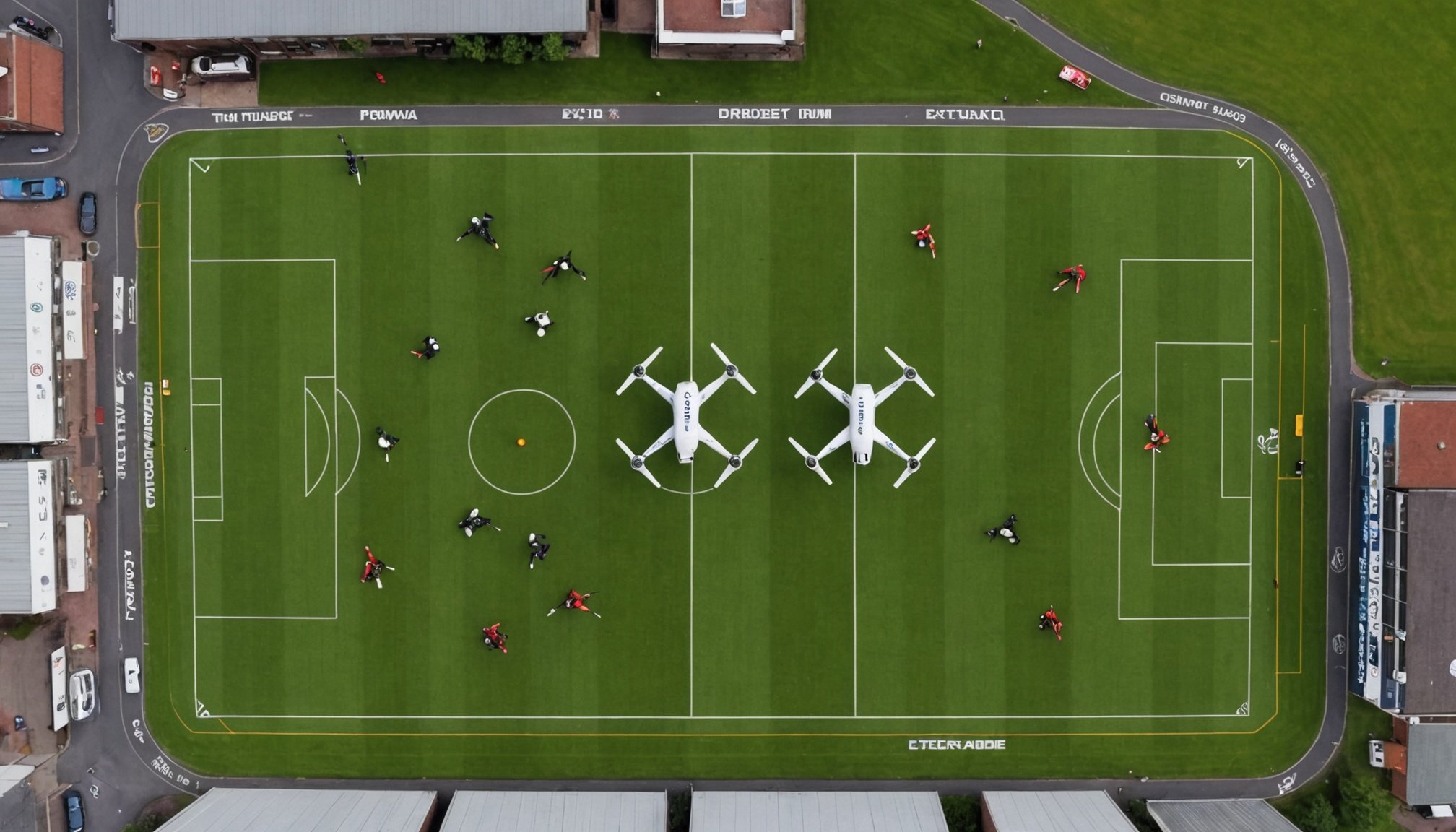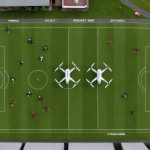Overview of Drone Technology in Sports
Drone technology has undergone a remarkable evolution, becoming an indispensable tool in the world of sports. Initially utilised for simple aerial shots, drones now capture high-quality footage that gives sports analysts and coaches unprecedented insights. The ability to record games and practices from unique angles enhances the observational capacity, providing UK sports clubs with detailed analytics.
Revolutionising Sports Analytics
Sports analytics has reached new heights with the advent of drones. These devices gather valuable data that allows teams to fine-tune their strategies, focusing on specific actions or players. Recording matches from a bird’s-eye view helps dissect team formations, player movements, and game dynamics. Such clarity in footage facilitates a more thorough understanding of pivotal moments and performance patterns.
In parallel : Enhancing Athlete Injury Prevention: Innovative Strategies for UK Sports Therapists to Incorporate Yoga
Unique Capabilities of Drones
Drones can glide effortlessly across the field, capturing every nuance of a game. The ability to fly at various heights and speeds ensures no detail goes unnoticed. For UK sports clubs, this means a step towards advanced data analysis, offering an edge over competitors. The precision and versatility of drone technology also make it a vital component in training sessions, where capturing real-time action aids in addressing weaknesses and improving performances.
In essence, drone technology’s role in sports analysis is transformative, enabling clubs to harness detailed insights and enhance their overall strategies.
In parallel : Revolutionizing Training: The Role of Virtual Reality in the Development of UK Sports Teams
Benefits of Leveraging Drone Footage
Integrating drone footage into sports programs offers a transformative edge in tactical enhancement. Coaches and analysts can gain a superior vantage point, allowing an unparalleled view of plays and formations. This holistic overview enhances situational awareness for both players and coaches. Teams can review complex game situations from multiple angles, leading to deeper insights.
Drone footage aids significantly in improving game strategy. By examining patterns and player movements, coaches can refine tactics based on the precise data captured. This leads to sophisticated in-depth analysis, offering teams the chance to adapt strategies more effectively against opponents.
Moreover, assessing individual and team performance becomes more rigorous and data-driven. This visual data enables pinpointing athlete strengths and areas needing improvement. Coaches can better understand how a player’s position impacts overall team dynamics, fostering tailored training sessions to enhance performance.
Incorporating drone technology into sports isn’t just about capturing stunning aerial shots—it fundamentally changes how teams prepare and compete. By offering detailed perspectives, it empowers teams to make informed, strategic decisions, boosting their chance of success. The benefits of drone footage in sports extend beyond the field, nurturing players’ skills and fortifying collective performance.
Case Studies of UK Sports Clubs Utilizing Drones
Examining how UK Sports Clubs adopt drones unveils fascinating stories of tactical innovations. These clubs integrate technology for a competitive edge.
Case Study: XYZ FC
XYZ FC, a football club in the UK, made strides by weaving drone footage into their training sessions. Drones offered unique, bird’s-eye perspectives that were previously unavailable, allowing coaches to scrutinize positioning and movement with unprecedented clarity. As a result, the team reported marked improvements in spatial awareness and communication on the pitch.
Coaches highlighted enhancements in tactical strategy, noting how visualising plays from above facilitated a better understanding of formations. Players expressed increased confidence, having seen their on-field actions and recognising areas for improvement visually.
Case Study: ABC Rugby Team
The ABC Rugby Team embraced drone technology for match analysis, revolutionising their approach to evaluating performance. The birds-eye footage captured by drones provided a comprehensive view of scrums and lineouts, offering insights into player dynamics.
Success stories abound, with performance metrics reflecting improvement in team coordination and strategy execution. Comparing traditional methods to drone technology, coaches acknowledged the latter’s advantage in offering holistic analysis. Whereas traditional recordings were more limited, drone footage offered expansive views, enabling more insightful discussions on tactics and game plans. Coaches and players alike noted increased effectiveness in training as a direct result of employing drones.
Technical Considerations for Implementing Drone Footage
Incorporating drone footage into sports clubs involves essential technical considerations, starting with selecting the right drone equipment. Opt for models with high-resolution cameras capable of capturing detailed action shots. Robust batteries and stabilisation systems ensure longer flight and steady footage. When considering equipment, remember that quality enhances usability and analysis.
The next step is the technical setup of the drones. Establish clear operational protocols, like setting flight zones, to ensure safety and efficiency. Regular equipment maintenance checks minimize the risk of malfunctions. Additionally, plan flights around the desired filming outcome and ensure proper communication within the team.
Training integration is crucial for maximizing the benefits of drone technology. Allocate time to train staff and players on how to interact with and interpret drone footage. Teaching operators the nuanced skills required to pilot drones can significantly enhance the quality of footage captured. Ensuring comprehension of data from these aerial perspectives can ultimately refine training techniques and strategies.
In summary, implementing drone technology is not merely about acquisition but involves a structured approach to setup and usage. When executed well, it can provide invaluable insights, fostering improved performance and strategic development in sports environments.
Integrating Drone Footage into Training Regimens
Drone footage is transforming training integration by offering unique perspectives that enhance coaching tactics in sports. Incorporating drone footage into regular training sessions requires strategic planning to ensure it maximizes its potential.
One effective method is conducting overhead video analysis, where coaches can observe player formations and movements that are not visible from ground level. This tactic helps identify inefficiencies or patterns in play that need improvement. Coaches can incorporate this analysis into training regimens, reinforcing necessary adjustments through tailored drills and exercises.
For instance, in football, drone footage can capture team dynamics during practice. Once recorded, coaches can highlight specific plays where positioning is critical. Players can then apply this feedback during tactical drills that mimic game scenarios. This repetitive cycle creates a feedback loop where athletes continuously build on prior performances, progressively enhancing their skills.
Player development is greatly facilitated by visualizing performance improvements, fostering a deeper understanding of team tactics. Coaches can use drone footage to facilitate one-on-one sessions, providing players with personalized insight into their performances. This allows for a more direct approach to addressing weaknesses and reinforcing strengths, leading to a solidified improvement in performance over time.
By leveraging these perspectives, teams can gain a competitive edge, ensuring coaching tactics are precise and impactful.
Future Trends of Drone Use in Sports
The future of sports technology is poised for significant transformation, driven by advancements in drones. As technology progresses, we can expect drones to become even more integral to sports analytics and performance enhancement. With innovations in drone capabilities, such as increased flight time and enhanced precision, their role in capturing real-time data is set to expand dramatically.
Emerging trends indicate that drones will offer unprecedented insights into team strategies and individual performances, allowing for more sophisticated analysis. For instance, drones can provide overhead views and track players’ movements with high precision—something that’s becoming increasingly invaluable for coaches in crafting game strategies.
However, the adoption of these advancements presents potential challenges, especially for UK sports clubs. Technological integration requires significant investment and a thorough understanding of the drone advancement landscape. Clubs must also navigate regulatory requirements, ensuring compliance with privacy and safety laws.
Moreover, as these innovations unfold, clubs will need to address concerns about data security and the ethical implications of surveillance. Balancing technology use with these considerations will be crucial for maintaining both competitive fairness and the spirit of the sport.
Ultimately, while drones promise to revolutionise sports, it is essential for stakeholders to align with innovations responsibly, ensuring that their use enhances rather than detracts from the essence of competition.











